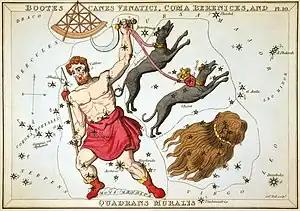Astronomia (poem)
The "Astronomia" (Ancient Greek: Ἀστρονομία, "Astronomy") or "Astrologia" (Ἀστρολογία, also "Astronomy") is a fragmentary Ancient Greek hexameter poem that was attributed to Hesiod during antiquity. As the title of the poem suggests, it was astronomical in focus, dealing with the stars.[1] It has been suspected that the Astronomia influenced the style of Aratus' Phaenomena, but the remains of the Hesiodic poem found in ancient quotations are too meager to allow for certainty on this matter.[2]

Title and authorship
While it is uncertain whether the work ought to be called the Astronomia or Astrologia,[3] either title would translate into English as "astronomy".[4] Athenaeus, who preserves three verbatim fragments of the poem, calls it the Astronomia, as does George Hamartolos (9th century AD).[5] Plutarch and Pliny the Elder, on the other hand, give Astrologia.[6] The 12th century AD poet and scholar Tzetzes struck his own course, preferring a periphrasis: βίβλος ἀστρική (biblos astrikē), "starry book".[7]
All these sources do agree on one point: there survives from antiquity no expression of doubt as to whether Hesiod wrote the Astronomia. Scholars of the 19th century, however, argued against Hesiodic authorship, going so far as to assign the poem to the Hellenistic Period following the work of Eudoxus.[1] Whether the transmitted fragments can be considered archaic or not, their small number and uninformative context leave open the possibility that they belonged to an expanded version of the Works and Days,[8] for the fragments' contents—the paths of the stars and their significance—betray a similarity to the astronomical advice in that poem that is, in the opinion of one modern scholar, "obvious."[9]
Content
Most of the surviving content of the Astronomia concerns two star groups: the Pleiades and the Hyades.[1]
Reception
The earliest likely reference to the Astronomia was no ringing endorsement. The author of the Epinomis states that no man should be called an astronomer if he, like "Hesiod", simply studied the risings and settings of the stars.[10]
Select editions and translations
Critical editions
- Hesiodi, Eumeli, Cinaethonis, Asii et Carminis Naupactii fragmenta, Guil. Marckscheffel (ed.), Lipsiae, sumtibus Fr. Chr. Guil. Vogelii, 1840, pp. 352-9.
- Hesiodi carmina, Johann Friedrich Dübner (ed.), Parisiis, editore Ambrosio Firmin Didot, 1841, p. 48.
- Rzach, A. (1908), Hesiodi Carmina (2nd rev. ed.), Leipzig
{{citation}}: CS1 maint: location missing publisher (link). - Merkelbach, R.; West, M.L. (1967), Fragmenta Hesiodea, Oxford, ISBN 0-19-814171-8
{{citation}}: CS1 maint: location missing publisher (link). - Merkelbach, R.; West, M.L. (1990), "Fragmenta selecta", in F. Solmsen (ed.), Hesiodi Theogonia, Opera et Dies, Scutum (3rd rev. ed.), Oxford, ISBN 0-19-814071-1
{{citation}}: CS1 maint: location missing publisher (link).
Translations
- Evelyn-White, H.G. (1936), Hesiod, the Homeric Hymns, and Homerica, Loeb Classical Library, vol. no. 57 (3rd rev. ed.), Cambridge, MA, ISBN 978-0-674-99063-0
{{citation}}: CS1 maint: location missing publisher (link). (The link is to the 1st edition of 1914.) - Most, G.W. (2006), Hesiod: Theogony, Works and Days, Testimonia, Loeb Classical Library, vol. no. 57, Cambridge, MA, ISBN 978-0-674-99622-9
{{citation}}: CS1 maint: location missing publisher (link). - Most, G.W. (2007), Hesiod: The Shield, Catalogue, Other Fragments, Loeb Classical Library, vol. no. 503, Cambridge, MA, ISBN 978-0-674-99623-6
{{citation}}: CS1 maint: location missing publisher (link).
Notes
- Cingano (2009, p. 129).
- Hopkinson (1988, pp. 136–7).
- Merkelbach & West (1967, p. 148).
- Liddel, H.G. & Scott, R. A Greek–English Lexicon, 9th ed. (Oxford, 1940), s.v. ἀστρονομιά and ἀστρολογία.
- Athenaeus, Deipnosophistae 11.80.491c–d; George Hamartolos, Chronicle 1.10.
- Plutarch, On Pythian Oracles 18.402f; Pliny, Natural History 18.213. Latin usage of astrologia parallels that of Greek in that only later did it connote exclusively something resembling modern astrology; cf. C.T. Lewis & C. Short, A Latin Dictionary (Oxford, 1879), s.v. astrologia.
- Tzetzes, Chiliades 12.167 and in his notes on Works and Days 384 = Astronomia fr. 291.
- Cingano (2009, p. 130).
- Most (2006, p. lxii).
- Plato (?), Epinomis 990a, quoted at Merkelbach & West (1967, p. 148).
Bibliography
- Cingano, E. (2009), "The Hesiodic Corpus", in Montanari; Rengakos; Tsagalis (eds.), Brill's Companion to Hesiod, Brill, pp. 91–130, ISBN 978-90-04-17840-3.
- Hopkinson, N. (1988), A Hellenistic Anthology, Cambridge, ISBN 978-0-521-31425-1
{{citation}}: CS1 maint: location missing publisher (link). - Montanari, F.; Rengakos, A.; Tsagalis, C. (2009), Brill's Companion to Hesiod, Leiden, ISBN 978-90-04-17840-3
{{citation}}: CS1 maint: location missing publisher (link). - Schwartz, J. (1960), Pseudo-Hesiodeia: recherches sur la composition, la diffusion et la disparition ancienne d'oeuvres attribuées à Hésiode, Leiden
{{citation}}: CS1 maint: location missing publisher (link). - West, M.L. (1978), Hesiod: Works & Days, Oxford, ISBN 0-19-814005-3
{{citation}}: CS1 maint: location missing publisher (link).